About the Ducati
(It becomes so long again, sorry..)
### My first scene of "Bevel".
It's an old story, when I was a college student. One of a
staff of my favorite bike shop had Ducati. It was MHR or something like
that of the "Bevel" era.
It's condition was always bad. Hardly started the engine. He said to
start it, he pushed over and over, after its battery had gone, till the
next bike shop of neighbor town. It could run rarely.
What was the merit of such a bike ?
He answered calmly. "It is an ownership feeling."
He said, it's the foreign made bike, owning itself is the glory premium.
It's expensive, but rots frequently, then needs more money. But the
owning of it is excellent experience beyond such kind of sufferings.
Boy, it doesn't run, but excellent?
It can't be.
Still now I can't understand whom prefers owning or polishing the bike
rather than riding. It might be an original experience is around here.
### About the Bevels.
Unfortunately, I've never seen the Bevels under perfect
condition, nor the real keen Bevel users. So it's a bit too tough for
me to say what the nature of Bevel.
I've ever seen the detail of its machinery though. It's quite unique.
At first, the beautiful engine makes an deep impression, it may rase
expectation for the power, but it shows a bit nervous feeling at the
same.
Also the framework is unique. Its cradle opens under the engine. It
doesn't seems to be so strong, especially for twisting force at the
braking approach to the corner.
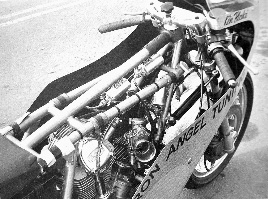 Racer in 1972, from ISBN1859606687.
Racer in 1972, from ISBN1859606687.
The engine is mounted a bit back and low, it would make stable load to
the rear wheel with narrow width. It would require a rider to control
it over its body rather than the front wheel, namely, it's the
traditional sports bike setting.
Well, I'm not sure about these impressions. I'd like to check it some
day to ride it actually.
Someone said its idling vibration makes it moves backward when it's put
on its stand. Is that true?
### My first F1
 From the ad. of that time.
From the ad. of that time.
Next time I saw Ducati was the F1 at a motorcycle show.
That was a bike released as a replica of pantah F2 racer. There was an
demo car provided for audience to sit on it freely. Of course I've sat
on it, but that was a curious bike.
It was so small as 750 cc, requires real racing position, which denies
loose sitting with thin and narrow seat and tight cowling which hits
the rider's knees. Handle bars rotate only very little.
I saw it from the side of it in detail again.
It was a serious bike, with small gas tank, carefully build frame work,
nervous positioned engine, hard suspension setting... all these shows
the passion of its designer, which is faced just to "speed".
There were many other Japanese racer replicas at that time, but they
were a bit nonsense. F1 differs.
I've remembered the words of a Ducati special shop owner.
"When I bought my first Ducati, I've felt that I'd like to be with it
even in sleeping time."
That F1 seemed to show me same kind of passion of that, I suppose.
And at the same time, I had some strangely feeling that I might not
approach it so easily. That sense continues even now.
### Normal F1.
At that time, it was a dawn of foreign bike market here in
Japan. Especially the Ducati was introduced on high level motorcycle
magazine with great passion and price.
In the weekend, I could see some F1 at biker's point, but almost all of
them seemed to be hard.
I could see the reason. F1 was so difficult bike.
Short wheelbase and narrow tires of F16/R18 inches show quick response,
but it was too much for average weekend riders. The engine prefers so
high revolution, that was so unique as a 750 cc twin cylinder bike
engine at that time. There was no consideration for easiness to get on
it.
It was a bike just intended to rush into the corner deeper, and dash
out by full power. That's all.
It should be a kind of devil for whom rode Japanese tender bike till yesterday.
It requires all the jobs to be dealt adequately, in another
words, it shows the riders skill frankly without any flattery. It had
been really nothing but the pain for usual level riders.
F1 owner seemed to be talking with the motorcycle silently between the
flying Japanese replicas.
### i ducatisti
Japanese seemed to begin actually enjoy foreign bikes at
that time. Sure, there was some marketing agitation like the
above-mentioned magazine for example, which raised
the volume with the remodeling of long-term testing F1 in a special
shop.
But the production quality of foreign motorbikes were poor at this
time, especially for Ducati, it's terrific. F1's mechanical weakness
required frequent fixing and repairs, and some of them are so deep
that might need almost same job of remodeling level.
Some F1 owner said "I will change the engine cam and combustion room
shape, then raise compression ratio, after adjustment of the carb and
ignition timing, then reinforce the clutch, transmission, tire, frame,
and suspension..."
It can't be said as repair, it's developing!
At that time, factory production level of Ducati were just to say as a
"corrupting primitives", which needs great care and cost to maintain.
But enthusiastic Ducati owners established peculiar culture to change
these suffering towards good direction.
You might see in the fine special shop of Ducati like...
- The bike given best priority to the improvement of the engine power, and the body was aimed to to endure it.
- The one aimed to the lightness of rolling at usual running course.
- The one tried to coexist of direct operation feeling and utility at low velocity in town.
- The one fitted new featured in mode without special consideration.
All the bikes are waiting for completion of assembly, accompanying a
coquettish tension peculiar to the Ducati.
I'd say, Ducati is not a manufacturer, but a constructor. All these
sight showed it to me.
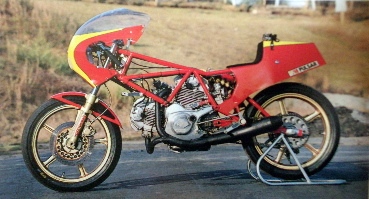
PANTAH RACING TT-F2, from RIDERS CLUB 1983-3 No.57.
### the job of Taglioni.
They say all that bikes revives its living vitality after the modifications.
It was very different things than the pity pushed MHR or F1 beginner.
It runs vividly with the rider of ability, who is capable to do all the
riding adequate. They say cheerfully "Do you see me?"
Ducati prefers to show its ability in circuit race, but it could not
apply to the public road riding directly. They need different methodology.
But I hesitate to talk this with the enthusiastic Ducati owners.
Their passion seems to be more complicated, or exists on different grade.
I guess their passions could be positioned on the apex of a triangle
based on a public road and racing track. Maybe that's the reason why
Ducati attracted so many passionate soul for so long time.
FABIO Taglioni.
What was the intension of him, who designed such kind of motorcycle?
They say this good man liked orchid and wine, and seems very gentle in
the photos. But I can't still describe how was the truth of Ducati's
hardness and wickedness. Further study would be needed.
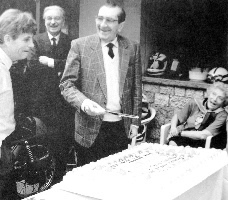
September, 1993 in birthday of 73 years old, from ISBN1859606687.
### SS ('89)
Another design conversion point next to the Bevel to Pantah
appeared in the change of F1 Montjuic to Bimota db1, which could be said
as the application of the radial tires. And that was followed by the 750SS
in 1988 as a production model. That runs low and smooth on 16-inch tires for
both of front and rear, which showed new movement for dynamic balance.
Then, in the following year, new 900SS appeared. It was a reinforced model
of previous 750SS for each parts such as engine and tires, etc.
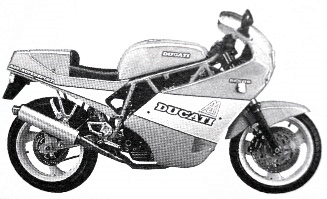 From the ad. at that time.
From the ad. at that time.
I've tested this SS before.
Unexpectedly normal SS was an easy bike, all of the engine and handling
were comparatively modest.
The most impressive point was that I do not feel the mass of the engine
so much. Usually, how to ride the bike is how to calm the weight of the
engine, because it's the heaviest component of the bike.
All the other bikes, 4 cylinders, BMW, Guzzi, etc. requires the same.
But this SS was different. It's very free to step into deep of the corners
on very high pace. But I've not tried actually because it would exceed
the level of test ride.
I've imaged that, on the Ducati, the spiral of pursuit and progress would
increase the toughness and severity. That's the right path of the sports,
but it's the opposite direction of the Japanese bikes, which proposes
the advantage of tool's performance rather than the human's skill.
I don't know which would contribute more to the riding joy. But it would
be clear that such sort of Ducati's character would make the riders
keen for everything over the bike riding.
Namely, "normal Ducati" is meaningless. It should be talked on each levels
of rider's concept or skills. And that should be applied also to the impression
articles.
Well, take care to read this, too.
### SS (after above model)
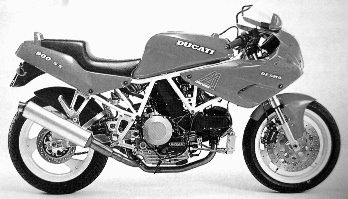 From the ad. at that time.
From the ad. at that time.
900SS was renewed in 1991, with brand-new appearance.
After that, SS continued to change on the context of improvement and
strengthening.
They said that the production level became fine at this time.
Some modification line the electrical equipment system's becoming
made in Japan etc. made this rumor seemed to be true.
Actually, it sold well, and it saw a lot also here in Japan.
I think it was the happiest time for SS.
But actually, there were some unhappiness, like the entrance of
water-cooled models and Monster, that made SS as a bit old-fashioned
modest one. Furthermore, SS buried itself between the many derivative
models with different displacement.
Ducati itself had many events. Thanks to the parent company with
the "Elephant" mark, capital flow became bad, that affected apparently
to the development, parts supply, etc.
SS continued to progress after that, and becomes a very sporty model
suitable for its name "Super Sport".
But it doesn't sell well. And the models are reducing.
It may be ending the tradition of Ducati SS with air-cooled engine.
I'm very disappointed.
### Monster
I've tested first model of Monster too.
Its riding position confused me. It placed rider forward ahead.
And its handlebars were wide and low. Off road type riding might fit it,
but foot steps were placed too backwards.
Frameworks and suspension system were a kind of reuse of water-cooled
newest ones, which had enough load capacity for hard level on road riding,
and of course the exiting Ducati engine tempted to do so.
What it requires differed from what it is.
It could be a easily exiting bike for town speed. It could be ridden
for riders of various level. That might be the reason why Ducati
released it, and the market's evaluation that it's getting still now.
Monster continues its development still now, with new power and
exiting features, but I can't understand its object still now. I don't
see whom loves Monster deeply, most of them seem to step up
to the another powerful bike, so the Monster use to become as a
second bike, I guess.
### ST, etc.
Below is an evaluation of ST4 veteran owner.
"It doesn't come very harmoniously. The steering head is too low."
You may say, low steering head is the goodness of Ducati.
Its L twin engine leaves the vicinity of the steering head
quite empty, it's suitable to keep it low and light.
Does he really understand its advantage?
No. It differs.
ST's seat is high (though all Ducati is high), and handlebars are also
high. Man is mounted far from roll axis, that is low and light as a
peculiar of Ducati. He says it's irritating that he's put apart from that
sweet control line.
Well, ST is a good bike as a sporty tourer, he runs very fast easily.
But if you like such a bike, it would be better the efficient BMW or
stable Japanese.
And now Ducati has Multistrada, that is also fast and easy. It's slim
and fit to the rider well, easy riding with wide handlebars,
luggage capacity is limited though.
I think Multistrada is not a off road bike, but a proposal of new style
of on road bike, market's evaluations are undistinguished though.
It seems that Ducati doesn't mind this architecture at all. It could be said
that Ducati ignores its traditional advantage, namely, the sporty feeling
that comes from light steering head beside the narrow and short handlebars.
It may need to estimate the intention of Ducati well, but I can't be
interested in it still now.
### Water-cooled Ducati
The series of Ducati water-cooled sports from
851 to 999 is in another context beside the air-cooling ones.
Its dawn, the story starts from the circuit.
(Being honest to the Ducati's history, it's rare case that the racer
precedes the production model.)
At that time, already the methodologies of motorcycle development
has shifted from the mechanical efficiency
to the spiral update of the load level and chip management scheme.
"You'd better to change the ROM first, before grinding the engine port."
How could Ducati set to the latest trend while maintaining its identity,
the combination of desmo valve system and L twin engine?
It's history sometimes showed hesitate.
L twin makes the body narrow, which is fine to roll the bike, but it also affects
both of the length and hight of the bike. It makes some limitations for mass distribution,
namely, the efficiency to extract the potential of the tires.
They say 916 to 998 shows quite different handling for their production year,
that might show the hesitate of Doug Polen or Carl Fogarti on the track itself.
Same kind of hesitate could be shown to the Sedici of Moto GP beside its rivals
that's running easily with highly mounted engine in short wheelbase.
And then, the change from 998 to 999 showed another perplexity.
For example, see a SBK scene of 2004. PF Chili of 998(body) runs
faster and faster on the alternative of "perfect win" or "high side",
while 999 runs far behind trying to accelerate with its rear tire burning.
That might show 998 turns well on body steering,
but 999 is modest on its cornering, that has more power though.
I don't say the production model equals that, but in that scene, I saw
Ducati's switch from the "exiting sports" to "efficiency for speed".
"An exotic bike that Japanese could never."
Wasn't it the reason why they loved Ducati enthusiastically ?
Pantah was small, light and tough exactly than the Japanese. That appealed
to the keen user.
Water-cooled Ducati is so powerful and fast. It's already
surpassed average level of street rider. And it's so big and heavy.
It's becoming harder to declare what's the difference or merit to the
Japanese.
It's becoming bigger, increasing performance, and more foolproof.
"Easy and fast. Over."
If it's the only way to get more performance following its traditional architect,
Ducati must know that from the first start of its development.
Wasn't it the truth of the "hesitation" ?
"If tire is good, Sedici can win."
It might be so.
But if it is, which was the good one, a tire or Sedici ?. (Maybe Capi.)
Ducati is vanishing.
They know it. But continues.
Why?
Sure, because it's for sales.
### Ducati for window display.
Well, it's a bit old story.
When the "Elephant" mark was attached at the sideward of Ducati's logo.
Ducati began to shift.
Some unfamiliar models were coming up beside its typical road sports,
like a modest tourer, easy chopper... And there also was the another derivatives
like Bimota db1. All these had the same heart, Ducati L twin.
Not only increasing the number of models, also its restyling became frequent.
It seemed the Ducati tried to cover wide range of models, which meant Ducati
was entering the same ring of Japanese giants, leaving its traditional territory.
Those was the revolutionary period that the motorbikes' design changed,
ex. radial tire, chip control system, etc. Also the Ducati had to change, shift,
and grow.
That situation put the Ducati on the inconsistency of "niche passion" and
"mainstream foolproof". Already it could not stand only on the passion of
traditional Ducati users. It had to appeal both to the "new" popular sense
and "old" traditional passion.
On that viewpoint, that obscure Monster begins to shine. It has done
indeed well to manage both of that alternative. As a proof,
It's achieving good sales.
Water-cooled Ducati can be put on the same context, I think.
It is Ducati's tradition to precede a racing image before
production. It could appeal premiere of the production to the market
efficiently and make easy to achieve the sales too. And also the users
were relieved on this image.
The market wished Ducati to continue putting such kind of images.
I'd say Ducati could continue its niche and keen road sports motorcycles,
but it's now decreasing and vanishing. Beside, new novel production line
was established in a conventional technique, for both of the brilliant
Ducati racing image and sales achievement.
This switching became clear when the Ducati parted with the "Elephant"
after some quarrels.
Now Ducati became an object of investment. If there's no capital, it isn't
possible to develop, manufacturing, anything.
"The achievement come first on above all. "
These days, it's a general seen that this kind of "fear" reflects to the
company's management. Ducati is the same.
 On the road.
On the road.
MH900e was symbolical. It's stylish indeed and cool. However, it moves
curious. Its rolling center is so high, and looks "like a GUZZI" in the most
unpleasant way for Ducatista. It can not be evaluated as a Ducati
sports motorcycle.
Just a style.
For ownership.
Good to put it behind the show window.
Yes, Ducati has matured.
For a while, It will continue vague chaos of novelty and succession
under the umbrella of brand image that's remaining traditional vividness.
Well, how will be the next of the Ducati?
I guess a next new production line will be created to maintain
its market and brand. That will be an new "exotic image" for Ducati future.
 Genuine Paul Smart ISBN 1859606687.
Genuine Paul Smart ISBN 1859606687.
### summary
Well, let's finish the historical overview and go back to the ducati product review.
Ducati models could be summarized briefly as below.
- Ones does not rely on tire : Bevel to Pantah
- Radial tire put them higher : Pantah to new SS
- Assuming radial since its beginning : After that
Above may be enough reminds for veteran whose favor is clear.
He would feel each generation of Ducati show definite difference,
but they all are based on Ducati's typical character. He will find
appropriate model to fit his values and empirical context.
Well, let's give an overview for newest Ducati models. It could be
divided into the two groups.
Fist is the models of novel image with brand-new looking,
like Monster, Multistrada, etc. Right, Ducati is wonderful to keep
such new trials, its developing effort could be evaluated.
But I can't still see "the essential purpose" on these models.
it's cool, right, but many other Japs are also cool.
OK, it's the Ducati. So, what's the benefit?
I can't understand whether it's a real innovation or a immature experiment, or just a cool toy.
Therefore, I can't explain your benefit to own these models,
especially on public road.
Second is the brave super sport, namely progressing liquid cooling 4-valve models.
Though it's increasing flexibility, but It's performance is so high and it will be a bit
too tough to ride it on public road, especially for an usual elder person like me.
It has too much margin, and it's almost useless.
I don't say Ducati is bad. It's a quite novel and cool. And It's your wallet and decision
whether you ride it or not. OK, go right ahead. And let me hear how you feel to ride it.
### My personal view.
My concept of Ducati.
I can't forget that hard image of F1.
For me, Ducati is a tool that Taglioni did to fight against my own limit of skill.
Ducati's light body and hard suspension requires correct load control, which means
dynamic riding to keep accelerating and braking fully effective.
And the L twin engine remains steering head light. It makes the balance of
body mass quite fine to realize such a dynamic riding.
Therefore, Ducati has become an irreplaceable partner for the rider
who prefers such a riding style.
A simple tool to equip for primitive passion. That's my hope for Ducati.
No, it's too late. It's nonsense to expect such a thing now.
Technology have brought it so far.
Ombra.
Feb. 2006
-- return to site top --
Copyright(C) 2005-2009 Public-road Motorcycle Laboratory All rights reserved.
 Racer in 1972, from ISBN1859606687.
Racer in 1972, from ISBN1859606687. From the ad. of that time.
From the ad. of that time. 

 From the ad. at that time.
From the ad. at that time. From the ad. at that time.
From the ad. at that time. On the road.
On the road. Genuine Paul Smart ISBN 1859606687.
Genuine Paul Smart ISBN 1859606687.